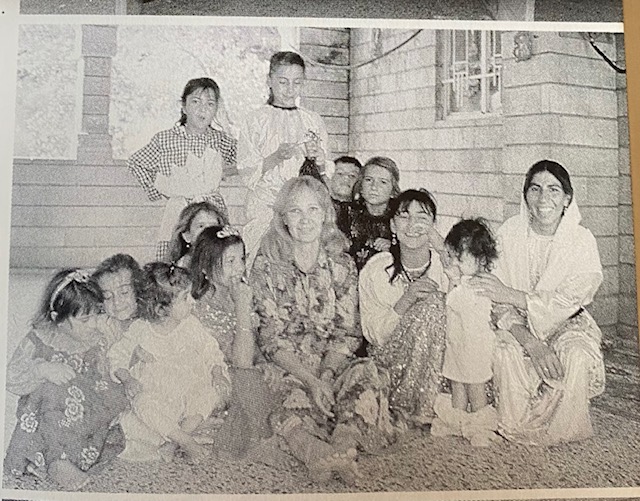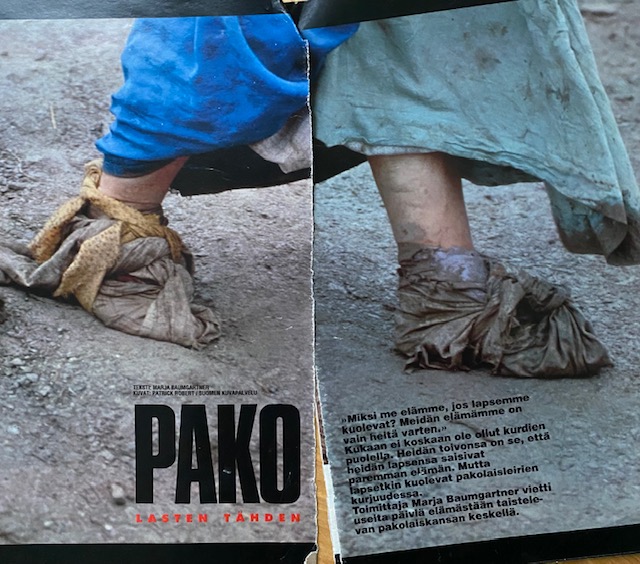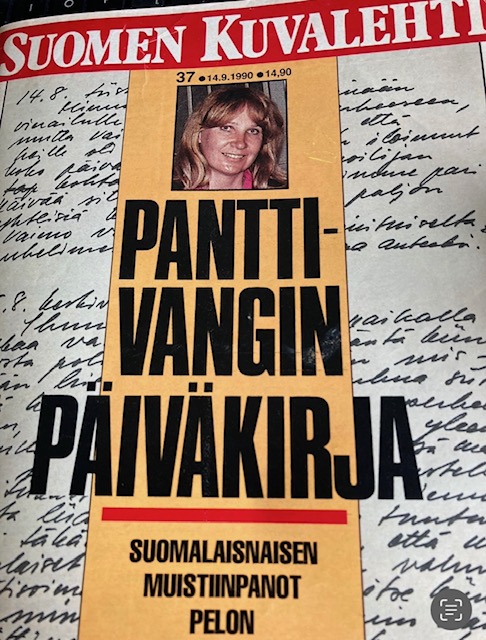In early August 1990, Finnish journalist Marja Baumgartner traveled to Lalish, the holiest temple of the Yezidis, which is located in a mountain valley in Shekhan, Duhok Governorate, Kurdistan Region of Iraq (KRI). Her visit was at the invitation of the Yezidis, a Kurdish-speaking religious minority living in Nineveh and Duhok governorates. Little did she know that the tumultuous events unfolding in the region would soon turn her world upside down.
While Marja was at Lalish, Iraq’s dictator Saddam Hussein made a fateful move to invade Kuwait. In the wake of this shocking development, Iraq swiftly closed its borders and airports, effectively trapping anyone – particularly Europeans – within the country. Marja, along with many other foreigners, found herself stranded in Iraq, with no immediate means of escape.

As she returned to her Baghdad hotel, Marja could not help but notice the growing number of foreigners who, like her, were confined to the hotel lobby, their freedom of movement severely restricted. Faced with the grim reality of her situation, Marja decided to make the most of her time by documenting the stories that were unfolding around her.
She went to Al Anbar Governorate in western Iraq to meet with Iranian children who were prisoners of war. She accompanied these young prisoners to Khanaqin, a city situated on the Iraq-Iran border, to witness the exchange of prisoners between the two countries.
Marja’s next attempt to leave Iraq led her to the city of Zakho, located on the Turkish border. However, her hopes were dashed once again as the border with Turkey was also sealed shut, denying her passage to safety.
She then returned to Baghdad, where Iraqi officials informed her that Hussein wanted to meet with her. Marja is still unsure whether he wanted to meet with her alone or with other journalists. She refused because she disliked the dictator.
As she recalled, “I said I’m sorry, I’m sick, I can’t come, I told them it’s dangerous for him as well, he might get sick,” describing her excuse for declining the invitation.
Marja ended up being stuck in Iraq for five weeks before a German plane arrived to pick up stranded Europeans. She recalled that the plane was so full that four people sat in three seats.

Passion for Kurdistan
Marja, who now lives in Switzerland, worked as a freelance journalist for publications in both Finland and Switzerland. Her trip to Iraq began in 1989, when she arrived in Baghdad. She decided to travel to what is now the KRI to interact with the Kurds and the Yezidis.
Her fascination with the Kurdish people dates to her childhood, when she read the adventure novel Through Wild Kurdistan by German author Karl May. As a journalist, her deepened after interviewing a Kurdish man from Turkey in Switzerland who regaled her with fascinating stories about the Kurds and the Yezidis. This encounter sparked a passion in Marja, inspiring her to pursue additional storytelling opportunities centered on Kurdish people.
Marja encountered a significant hurdle when she tried to reach the Kurdistan Region: at the time, the Iraqi government strictly prohibited foreign journalists from traveling to Kurdistan to engage with the Kurds and Yezidis.

Despite that, she set out for Mosul in northern Iraq, and from there, she traveled to Sinjar, where she sought to meet with the Yezidis. The Yezidis, on the other hand, warned her about the dangers posed by her presence in the region – and her intention to document their stories – if the Iraqi government became aware of her activities.
During the Gulf War in 1991, Iraqi Kurds rose up against Saddam’s rule and were able to defeat the Iraqi army and establish their own autonomous region. Since then, Marja has visited the KRI almost every year.
However, due to Saddam’s embargo on the KRI, traveling to the region was difficult. From Baghdad, she had to go to Jordan, then Syria, then Turkey, and finally the KRI. It took her two weeks to travel from Baghdad to Erbil, the capital of the KRI, a trip that normally takes four hours.
“What can I say, I like adventures,” she chuckled.

Orphans of the Universe
Marja did not visit KRI from 2005 until 2014, when ISIS took control of Mosul. She was in Finland at the time, watching TV, when she saw Vian Dakhil, the only Yezidi Kurd in the Iraqi Parliament, crying and pleading for international help for the Yezidis, who were being slaughtered by ISIS. Marja knew Vian because she used to stay at her house when she was in Kurdistan.
Immediately, she returned to the KRI and began collecting donations from Finnish women all over the world to help Yezidis who had been displaced by ISIS attacks.
“It wasn’t a lot of money, but we did a lot with it,” she explained.
Marja has written two books about Iraq and the Kurds. Her first, In the Land of Saddam and Fairytales, was published in 1992 and is about her trips to Iraq and the stories she encountered there. Her second book, Orphans of the Universe, about Kurds and Yezidis, was released in 2019. Marja said she took inspiration from a quote by legendary Kurdish leader Mustafa Barzani for the title of her second book.

She is currently working on her third book about Kurdish women throughout history.
Describing the Kurdish people, she affectionately characterizes them as “lovely people.” She highlights their curiosity about life, openness to meeting new people, and the immense importance they place on family bonds. She recalls, “No one bothered me in Kurdistan; I was free, I only encountered friendliness.”
Marja believes that Kurdish women are making progress toward greater independence, though she wants to see them take even more initiative for themselves. She contends that, compared to women in the rest of Iraq, Kurdish women have forged significant inroads in this regard.
Marja ended her interview by urging Kurds to “stay together, be united, and never forget their dreams.”